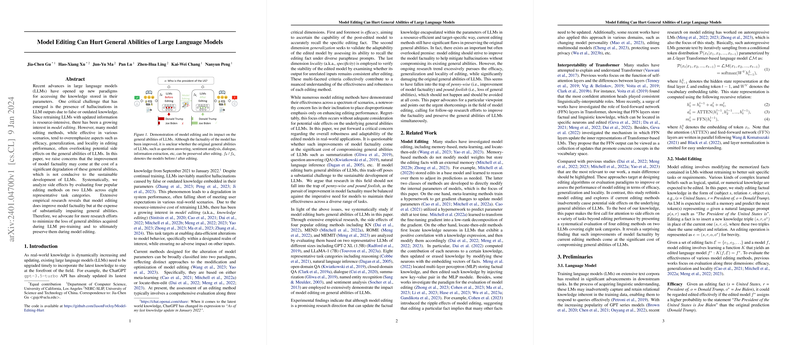Introduction
Artificial intelligence has made significant leaps in recent years, particularly in the field of NLP. LLMs—LLMs—have shown remarkable abilities to generate text, answer questions, and even create poetry. But as powerful as these models are, their knowledge is frozen at the point they were last trained. They can produce content that is outdated or just plain wrong, something that's referred to as "hallucinations." While retraining models with updated information is the ideal solution, doing so requires substantial computational resources. To address this, researchers have turned to "model editing," a process that involves tweaking a model's details to correct misinformation. However, a growing body of research suggests that these edits, while correcting one issue, might be deteriorating the overall abilities of LLMs.
Related Work
Model editing is an active area of research, aiming to keep LLMs accurate without the need for full retraining. Methods for model editing have evolved, with some focusing on memory-based approaches that work outside the model, while others employ meta-learning techniques or pinpoint and edit specific neurons associated with particular facts. Despite advancements, till now, the predominant focus has been on improving the editing performance specifically, often paying less attention to the broader impact on the model's abilities.
Evaluating Model Editing
This paper critically examines four popular model editing methods across eight task categories within two different LLMs. The methods—KN, MEND, ROME, and MEMIT—vary in their approach to editing, from modifying key neurons to using a hypernetwork that adjusts model weights based on specific inputs. Assessments include a variety of editing scenarios, like instance vs. batch editing, and single vs. sequential editing. The findings are profound, showing that while editing can effectively update specific pieces of information, it often results in a drop in performance on other general tasks such as question answering and sentiment analysis.
Conclusion and Discussion
The conclusion is cautionary: while model editing is a seemingly promising direction, there is a trade-off in the general task performance of LLMs. The analysis reveals a concerning trend of performance degradation with increase in editing operations or batch sizes, indicating that current editing techniques may be undermining the robustness of these models. The paper calls for future research to refine model editing methods, aiming to preserve the breadth of LLMs' capabilities while enhancing their factual accuracy. This is not just about improving individual tasks, but about ensuring the sustainable development of LLMs as reliable, general-purpose tools for various applications.
In this rapidly evolving field, the ongoing challenge is to balance the need for accurate, up-to-date information with the imperative to maintain a model's general abilities. Only with continued scrutiny and innovative approaches can the full potential of AI be harnessed responsibly.
